|
|
|

|
|
2008 (vol. 8)
|
|
Article 9 [2008]: Spirochetes and salt marsh microbial mat geochemistry: Implications for the fossil record, by Elizabeth A. STEPHENS, Olivier BRAISSANT & Pieter T. VISSCHER.-
Format [HTML]
or [PDF
315 KB]
Reference: [CG2008_A09]
DOI:
10.4267/2042/20045
Lang.:
|
|
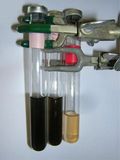 Abstract: Microbial mats are
synergistic microbial consortia through which major elements, including sulfur,
are cycled due to microbial and geological processes. Depth profiles of pH, O2,
sulfide, exopolymeric substances (EPS), and the rate of sulfate reduction were
determined in an Oscillatoria sp. and Microcoleus-dominated marine
microbial mat at the Great Sippewissett salt marsh, Massachusetts. In addition,
measurements in spirochete enrichments and Spirochaetae litoralis
cultures showed sulfide consumption during which polysulfides, thiosulfate, and
presumably sulfate formed. These data suggest that spirochetes can play a role
in the cycling of sulfur in these mats. The obligate to facultative anaerobic
spirochetes may consume sulfide to remove oxygen. Furthermore, spirochetes may
enhance preservation of microbial mats within the rock record by degrading EPS
and producing low molecular weight organic compounds (LMWOC). Both sulfide
oxidation (i.e., oxygen removal) and EPS degradation (i.e.,
production of LMW organic compounds) stimulate the activity of sulfate-reducing
bacteria (SRB), which are responsible for the precipitation of calcium carbonate
in most lithifying mats. Abstract: Microbial mats are
synergistic microbial consortia through which major elements, including sulfur,
are cycled due to microbial and geological processes. Depth profiles of pH, O2,
sulfide, exopolymeric substances (EPS), and the rate of sulfate reduction were
determined in an Oscillatoria sp. and Microcoleus-dominated marine
microbial mat at the Great Sippewissett salt marsh, Massachusetts. In addition,
measurements in spirochete enrichments and Spirochaetae litoralis
cultures showed sulfide consumption during which polysulfides, thiosulfate, and
presumably sulfate formed. These data suggest that spirochetes can play a role
in the cycling of sulfur in these mats. The obligate to facultative anaerobic
spirochetes may consume sulfide to remove oxygen. Furthermore, spirochetes may
enhance preservation of microbial mats within the rock record by degrading EPS
and producing low molecular weight organic compounds (LMWOC). Both sulfide
oxidation (i.e., oxygen removal) and EPS degradation (i.e.,
production of LMW organic compounds) stimulate the activity of sulfate-reducing
bacteria (SRB), which are responsible for the precipitation of calcium carbonate
in most lithifying mats.
|
|
Online since December 10, 2008
|
|
Article 8 [2008]: On the history of the names Lingula, anatina, and on the confusion of the forms assigned them among the Brachiopoda, by Christian C. EMIG.-
Format [HTML]
or [PDF
1,225 KB]
Reference: [CG2008_A08]
DOI:
10.4267/2042/20044
Lang.:
|
|
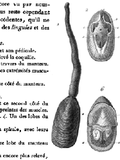 Abstract: The The first
descriptions of Lingula were made from then extant specimens by three
famous French scientists: Bruguière, Cuvier,
and Lamarck. The genus Lingula was created in
1791 (not 1797) by Bruguière and in 1801 Lamarck
named the first species L. anatina, which was then studied by Cuvier
(1802). In 1812 the first fossil lingulids were discovered in the Mesozoic and
Palaeozoic strata of the U.K. and were referred to Lingula on the basis
of similarity in the form of the shell. In the 1840's other linguliform
brachiopods from the Palaeozoic were described. The similarity of the shell form
of the extant Lingula and these fossils led Darwin
in 1859 to create the description "living fossil" in his book "On
the Origin of Species". Thereafter, this Darwinian concept became
traditional in that Lingula was considered to lack morphological
evolutionary changes. Although denounced as scientifically incorrect for more
than two decades, the concept still remains in many books, publications and Web
sites, perhaps a witness to palaeontological conservatism. Abstract: The The first
descriptions of Lingula were made from then extant specimens by three
famous French scientists: Bruguière, Cuvier,
and Lamarck. The genus Lingula was created in
1791 (not 1797) by Bruguière and in 1801 Lamarck
named the first species L. anatina, which was then studied by Cuvier
(1802). In 1812 the first fossil lingulids were discovered in the Mesozoic and
Palaeozoic strata of the U.K. and were referred to Lingula on the basis
of similarity in the form of the shell. In the 1840's other linguliform
brachiopods from the Palaeozoic were described. The similarity of the shell form
of the extant Lingula and these fossils led Darwin
in 1859 to create the description "living fossil" in his book "On
the Origin of Species". Thereafter, this Darwinian concept became
traditional in that Lingula was considered to lack morphological
evolutionary changes. Although denounced as scientifically incorrect for more
than two decades, the concept still remains in many books, publications and Web
sites, perhaps a witness to palaeontological conservatism.
|
|
Online since December 10, 2008
|
|
Memoir 4 [2008]: Aptian and Albian Phylloceratids (Ammonoidea) from the Vocontian Basin (SE France), by Bernard JOLY & Michel DELAMETTE.-
Format [HTML]
or [PDF
6,688 KB]
Reference: [CG2008_M04]
DOI:
10.4267/2042/19113
Lang.:
|
|
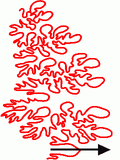 Extended English abstract: More than 2,200 pyritized ammonites of the Superfamily Phylloceratatoidea
have been collected in consonance with the scale of the ammonite zonation of the
expanded Marnes Bleues Fm in the Vocontian Basin (SE France). This abundant material allows the description and the figuration
(specimens and sutures) of 28 taxa of which 4 are new: Extended English abstract: More than 2,200 pyritized ammonites of the Superfamily Phylloceratatoidea
have been collected in consonance with the scale of the ammonite zonation of the
expanded Marnes Bleues Fm in the Vocontian Basin (SE France). This abundant material allows the description and the figuration
(specimens and sutures) of 28 taxa of which 4 are new:
- Phylloceras (Hypophylloceras) moriezense Sayn, 1920
subsp. tenuicostulata nov. Diagnosis: variant of P. (H.) moriezense distinguished by a subrectangular section of the whorl and
a flattening of the sides less accentuated than on the typical form, with a
very fine costulation that descends almost to the middle of the side (early late Aptian);
- Phylloceras (Goretophylloceras) vocontium nov. sp. Diagnosis: thick
shell, convex sides, rounded and compressed
venter, maximum thickness of the whorl near the umbilicus, open umbilicus, constrictions at least at the beginning of the last
whorl, oval whorl section, suture line of subgenus Goretophylloceras
(mid middle Aptian to earliest Albian);
- Salfeldiella (Gyrophyllites) falloti nov. sp. Diagnosis: shell with a finely
costulate test, smooth internal mold, open umbilicus, nearly flat sides, rounded
venter, subquadratic whorl section, proverse constrictions of the internal
mold, radial constrictions
in small specimens, a ventral sinus in the largest specimens, suture line
like that of the genus Gyrophyllites (late Early Aptian to late Aptian);
- Phyllopachyceras brehereti nov. sp. Diagnosis: thick shell, flat
sides, venter flat or slightly convex, whorl quadratic in section, suture lines like those of the genus Phyllopachyceras with tetraphyllic spatulate elongated saddles
(early mid-Aptian to early late Aptian).
Owing to the abundance of the Phylloceratoidea and the variations of specific
diversity in 9 fossiliferous levels ranging in age from the late Early Aptian to
the end of the Albian it is possible to identify 3 peaks of abundance:
- peak 1 during the early mid-Aptian (base of the Martini zone),
- peak 2 near the Aptian and Albian boundary, a few meters below the anoxic Paquier level,
- peak 3 during the latest Albian (Blancheti zone).
Of these 3 peaks the first is the most important probably because the Vocontian Basin
attained its maximum depth during this time. The peaks appear to be correlated with the maximum flooding intervals of depositional
sequences. But high sea-levels
were not always favourable for the Phylloceratoidea. The very fossiliferous Paquier
level, although it took place during a high in sea-level, is characterised by the virtual absence of the deep-water ammonites, e.g.
Phylloceratids, Tetragonids and Lytoceratids. This fact is explained by the presence of
a deep-water anoxia. Another depletion of Phylloceratoidea in conjonction with a great abundance of
Desmoceratid and Mortoniceratid ammonites and benthic fauna (Inoceramids Bivalves) occurred during the early Late Albian. At that time, the
Vocontian area appears to have reached a minimal depth resulting from a pause in the rate of subsidence associated
with an influx of siliciclastic material that attained the center of the basin.
After a last episode during the Early Cenomanian of the Vocontian Basin when the Phylloceratoidea occurred
significant number, this group of ammonites shows a drastic decrease in
abundance. This evolution is correlated with the filling of the basin from west to
east, thus restricting the Phylloceratoidea and the other deep-water ammonites to a small eastern area (Leiostraca area of Thomel,
1965, 1980).
|
|
Online since September 28, 2008
|
|
Article 7 [2008]: Holostratigraphy of the Kahmah regional Series in Oman, Qatar, and the United Arab Emirates, by Bruno GRANIER.-
Format [HTML]
or [PDF
2,154 KB]
Reference: [CG2008_A07]
DOI:
10.4267/2042/19112
Lang.:
|
|
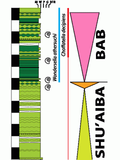 Abstract: The stratigraphic framework of the uppermost Jurassic - Lower Cretaceous interval of the Gulf area is revised
using both historical and recently acquired paleontological (ammonites,
calpionellids, foraminifers, 'calcareous' algae), sedimentological and sequential
information. The Kahmah regional Series ranging in age from Late Tithonian to Gargasian (= middle Aptian) times is subdivided into regional stages, named from bottom to top: Rayda (with two substages, Bu Haseer and
Belbazem), Salil, Zakum, Lekhwair, Kharaib, Hawar, and Shu'aiba. The Kahmah rests
either on strata representing the Habshan regional Stage, which is the last term of the Sahtan regional Series
(locally absent due to a stratigraphic hiatus in basinal areas), or on much older
strata; it is followed either by the Bab regional Stage (locally absent due to a stratigraphic hiatus on platform areas), or by the Sabsab regional Substage (the lowermost part of the Nahr Umr regional Stage), both of which are assigned the Wasi'a regional Series. The Kahmah succession
(as well as those of the Sahtan below and the Wasi'a above) is
discontinuous, i.e. punctuated by sedimentary hiatuses due to forced regressions, some of significant importance (in the Zakum or in the
Bab, and those bounding the Hawar and the Shu'aiba). Abstract: The stratigraphic framework of the uppermost Jurassic - Lower Cretaceous interval of the Gulf area is revised
using both historical and recently acquired paleontological (ammonites,
calpionellids, foraminifers, 'calcareous' algae), sedimentological and sequential
information. The Kahmah regional Series ranging in age from Late Tithonian to Gargasian (= middle Aptian) times is subdivided into regional stages, named from bottom to top: Rayda (with two substages, Bu Haseer and
Belbazem), Salil, Zakum, Lekhwair, Kharaib, Hawar, and Shu'aiba. The Kahmah rests
either on strata representing the Habshan regional Stage, which is the last term of the Sahtan regional Series
(locally absent due to a stratigraphic hiatus in basinal areas), or on much older
strata; it is followed either by the Bab regional Stage (locally absent due to a stratigraphic hiatus on platform areas), or by the Sabsab regional Substage (the lowermost part of the Nahr Umr regional Stage), both of which are assigned the Wasi'a regional Series. The Kahmah succession
(as well as those of the Sahtan below and the Wasi'a above) is
discontinuous, i.e. punctuated by sedimentary hiatuses due to forced regressions, some of significant importance (in the Zakum or in the
Bab, and those bounding the Hawar and the Shu'aiba).
|
|
Online since September 28, 2008
|
|
Article
7 [vol. 8, no. A07, 2008] - an extra video: Holostratigraphy of the Kahmah regional Series in Oman, Qatar, and the United Arab Emirates, by Bruno GRANIER.-
The video of Fig.
18  revisited revisited
|
|
Click on image to play the video file (flv = 5,029 KB)
|
|
Online since May 22, 2010
|
|
Memoir 3 [2008]: The Douvilleiceratidae (Ammonoidea) of the Lower Aptian historical stratotype area at Cassis-La Bédoule (SE France), by Pierre ROPOLO, Gabriel CONTE, Michel MOULLADE, Guy TRONCHETTI & Roland GONNET.-
Format [HTML]
or [PDF
6,688 KB]
Reference: [CG2008_M03]
DOI:
10.4267/2042/18125
Lang.:
|
|
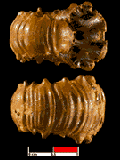 Abstract: Recent biostratigraphic research in the marly limestones of the Cassis-La Bédoule area (SE France) provided a rich macrofauna of Douvilleiceratidae Parona & Bonarelli,
1897. From the uppermost Barremian (Pseudocrioceras waagenoides Subzone) to the middle Aptian (Parahoplites melchioris Zone), specimens of Procheloniceras, Cheloniceras, Roloboceras, Megatyloceras and Epicheloniceras were collected in succession. In this paper we describe the various genera and species from this material and delimit precisely their stratigraphic positions. Our study shows that each genus or subgenus characterizes a discrete stratigraphic interval. In addition, the Cheloniceras meyendorffi
(upper Bedoulian), Epicheloniceras debile, Epicheloniceras gracile, and Epicheloniceras buxtorfi
(Gargasian = middle Aptian) subzones, originally defined in England by Casey (1961a), are identified for the first time in the
Lower Aptian stratotypic area of Cassis-La Bédoule. Abstract: Recent biostratigraphic research in the marly limestones of the Cassis-La Bédoule area (SE France) provided a rich macrofauna of Douvilleiceratidae Parona & Bonarelli,
1897. From the uppermost Barremian (Pseudocrioceras waagenoides Subzone) to the middle Aptian (Parahoplites melchioris Zone), specimens of Procheloniceras, Cheloniceras, Roloboceras, Megatyloceras and Epicheloniceras were collected in succession. In this paper we describe the various genera and species from this material and delimit precisely their stratigraphic positions. Our study shows that each genus or subgenus characterizes a discrete stratigraphic interval. In addition, the Cheloniceras meyendorffi
(upper Bedoulian), Epicheloniceras debile, Epicheloniceras gracile, and Epicheloniceras buxtorfi
(Gargasian = middle Aptian) subzones, originally defined in England by Casey (1961a), are identified for the first time in the
Lower Aptian stratotypic area of Cassis-La Bédoule.
|
|
Erratum: The photo of a specimen of Megatyloceras ricordeanum (d'Orbigny) from
the private collection of Cyril Baudouin and coming from the locality of Le Teil (Ardèche) is figured in the memoir of P. Ropolo et alii (2008, Pl. 08, fig. 3  )
instead of and in place of a specimen collected at La Bédoule. The first author
(P.R.) tells us that it was because of an error in the labeling
of his photographic archives that this unfortunate substitution could occur. He asks not just the owner of
the photograph and the ammonite, Cyril Baudouin,
but also his co-authors and the editors and readers of Carnets to be good enough to pardon him for this
unintentional error. )
instead of and in place of a specimen collected at La Bédoule. The first author
(P.R.) tells us that it was because of an error in the labeling
of his photographic archives that this unfortunate substitution could occur. He asks not just the owner of
the photograph and the ammonite, Cyril Baudouin,
but also his co-authors and the editors and readers of Carnets to be good enough to pardon him for this
unintentional error.
We remind you that the whole of the material illustrated in
this memoir is already deposited or is being deposited, is catalogued or is
being catalogued in the Museum of Paleontology of the University of Provence
(Aix-Marseilles 1), St. Charles Campus.
|
|
Format [HTML]
ou [PDF
76 KB]
|
|
Online since August 27, 2008
|
|
Letter 3 [2008]: About the stratigraphic position of the Lower Aptian Roloboceras hambrovi (Ammonoidea) level, by Pierre ROPOLO, Michel MOULLADE, Gabriel CONTE & Guy TRONCHETTI.-
Format [HTML] or [PDF
180 KB]
Reference: [CG2008_L03]
DOI:
10.4267/2042/18124
Lang.:
|
|
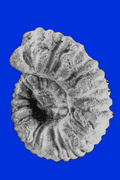 Abstract: In the stratotype of the Lower Aptian substage the position of the assemblage that includes Roloboceras spp. and Megatyloceras spp. has been clearly established as being in the middle part of the upper Bedoulian. Some authors have erected this horizon as a subzone, or even a zone, with R. hambrovi as species-index. In other areas (southern England, eastern Spain, the Ardèche in southeastern France), where taphonomic conditions are not always as favourable as they are in the stratotype, the level at which this assemblage occurs seems to be confined to the upper part of the lower Bedoulian. Various hypotheses are considered in an attempt to explain this divergence. Abstract: In the stratotype of the Lower Aptian substage the position of the assemblage that includes Roloboceras spp. and Megatyloceras spp. has been clearly established as being in the middle part of the upper Bedoulian. Some authors have erected this horizon as a subzone, or even a zone, with R. hambrovi as species-index. In other areas (southern England, eastern Spain, the Ardèche in southeastern France), where taphonomic conditions are not always as favourable as they are in the stratotype, the level at which this assemblage occurs seems to be confined to the upper part of the lower Bedoulian. Various hypotheses are considered in an attempt to explain this divergence.
|
|
Online since August 27, 2008
|
|
Article 6 [2008]: Middle Jurassic to Lower Cretaceous continental deposits from eastern High Atlas (Morocco): successive paleoenvironments and paleogeographic significance, by Hamid HADDOUMI, André CHARRIÈRE, Bernard ANDREU & Pierre-Olivier MOJON.-
Format [HTML]
or [PDF
2,069 KB]
Reference: [CG2008_A06]
DOI:
10.4267/2042/18122
Lang.:
|
|
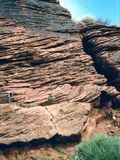 Abstract: In the eastern High Atlas (Morocco), continental "Red Beds" overlying the last marine deposits of Jurassic age consist of three main lithostratigraphic units: the Anoual Formation, the Ksar Metlili Formation and the Dekkar Group, bounded by two sharp sedimentary discontinuities. The Anoual Formation is a fluvial dominated deltaic plain deposit. It is followed by a final marine transgression of Early Bathonian age. The Ksar Metlili Formation found only in some subsident areas represents a renewal of
fluvio-deltaic environments with a flora of Late Tithonian-Early Berriasian
charophytes. The Dekkar Group occupies a larger area of sedimentation, its limits overlap the whole domain. From bottom to top, the succession indicates the existence of three
paleoenvironments: alluvial fans deposits locally associated with Barremian?-Aptian lacustrine sediments containing charophytes and
ostracods, alluvial plains deposits and finally, marine coastal to brackish plains deposits of the Cenomanian. Abstract: In the eastern High Atlas (Morocco), continental "Red Beds" overlying the last marine deposits of Jurassic age consist of three main lithostratigraphic units: the Anoual Formation, the Ksar Metlili Formation and the Dekkar Group, bounded by two sharp sedimentary discontinuities. The Anoual Formation is a fluvial dominated deltaic plain deposit. It is followed by a final marine transgression of Early Bathonian age. The Ksar Metlili Formation found only in some subsident areas represents a renewal of
fluvio-deltaic environments with a flora of Late Tithonian-Early Berriasian
charophytes. The Dekkar Group occupies a larger area of sedimentation, its limits overlap the whole domain. From bottom to top, the succession indicates the existence of three
paleoenvironments: alluvial fans deposits locally associated with Barremian?-Aptian lacustrine sediments containing charophytes and
ostracods, alluvial plains deposits and finally, marine coastal to brackish plains deposits of the Cenomanian.
After the closure of the Jurassic Atlasic marine trough, the eastern Atlasic "Red Beds" were deposited in response to three main geodynamic events:
- the filling of the Atlasic trough with very thick deposits in subsiding areas linked to tectonic rifting during the Early
Bathonian;
- the emergence of this area caused a hiatus in sedimentation involving strata ranging in age from Bathonian to Barremian?-Aptian. However, continental sediments are preserved in some onshore geomorphological depressions at the Jurassic/Cretaceous boundary;
- the opening of new basins, continental during the Barremian?-Aptian, that became marine during the Late Cenomanian as the result of Cenomanian-Turonian transgression.
A comparison of the succession of events recorded in different parts of the Atlasic belts allows reconstruction of the three phases of paleogeographic evolution in these southern Tethyan areas during Middle Jurassic to Late Cretaceous times.
|
|
Online since August 1, 2008
|
|
Letter 2 [2008]: Zonation by ammonites and foraminifers of the Vraconnian-Turonian interval: A comparison of the Boreal and Tethyan domains (NW Europe / Central Tunisia), by Francis AMÉDRO & Francis ROBASZYNSKI.-
Format [HTML] or [PDF
144 KB]
Reference: [CG2008_L02]
DOI:
10.4267/2042/17066
Lang.:
|
|
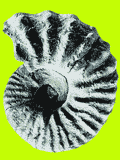 Abstract: Since the end of the 19th century the interval comprising the uppermost Upper Albian, the
Cenomamian, the Turonian and the basal Coniacian has been subdivided, first into ammonite zones, then, beginning in the middle of the 20th century, into zones of planktonic foraminifera. These two groups, one macrofossil, the other microfossil, are particularly effective for
bio-chronostratigraphy thanks to their rapid rates of evolution. But differences in the faunal makeup between the Boreal domain (northwestern Europe) and the Tethyan domain (Mediterranean) have for a long time hindered precise correlation of the two domains. Today, in a time interval covering about 16 million years, there are 29 ammonite zones in the Tethyan domain versus 24 in the Boreal one, of which 16 are common to both domains. For the planktonic foraminifera the Tethyan domain has 11 zones, the Boreal domain 10, with 7 in
common. Abstract: Since the end of the 19th century the interval comprising the uppermost Upper Albian, the
Cenomamian, the Turonian and the basal Coniacian has been subdivided, first into ammonite zones, then, beginning in the middle of the 20th century, into zones of planktonic foraminifera. These two groups, one macrofossil, the other microfossil, are particularly effective for
bio-chronostratigraphy thanks to their rapid rates of evolution. But differences in the faunal makeup between the Boreal domain (northwestern Europe) and the Tethyan domain (Mediterranean) have for a long time hindered precise correlation of the two domains. Today, in a time interval covering about 16 million years, there are 29 ammonite zones in the Tethyan domain versus 24 in the Boreal one, of which 16 are common to both domains. For the planktonic foraminifera the Tethyan domain has 11 zones, the Boreal domain 10, with 7 in
common.
|
|
Online since May 17, 2008
|
|
Memoir 2 [2008]: Support for a Vraconnian Stage between the Albian sensu stricto and the Cenomanian (Cretaceous System), by Francis AMÉDRO.-
Format [HTML] or [PDF
8,921 KB]
Reference: [CG2008_M02]
DOI:
10.4267/2042/17063
Lang.:
|
|
 Abstract: The geological scale for the middle Cretaceous currently used throughout the world was proposed by Alcide d'Orbigny in the XIXth century between the years 1842 and 1847 and establishes the succession of stages as Albian, Cenomanian and Turonian. In 1868 Renevier proposed that a supplemental chronostratigraphic division be intercalated between the Albian and the Cenomanian: the Vraconnian stage. This term was not generally accepted and after a period when it was referred to by Breistroffer (1936) as a substage constituting the upper part of the Albian, as an equivalent of the Stoliczkaia dispar ammonite Zone, its abandonment was "recommended" by the Conference on the Lower Cretaceous held in Lyon in 1963. The conditions that led to this "decision" will be discussed herein. Abstract: The geological scale for the middle Cretaceous currently used throughout the world was proposed by Alcide d'Orbigny in the XIXth century between the years 1842 and 1847 and establishes the succession of stages as Albian, Cenomanian and Turonian. In 1868 Renevier proposed that a supplemental chronostratigraphic division be intercalated between the Albian and the Cenomanian: the Vraconnian stage. This term was not generally accepted and after a period when it was referred to by Breistroffer (1936) as a substage constituting the upper part of the Albian, as an equivalent of the Stoliczkaia dispar ammonite Zone, its abandonment was "recommended" by the Conference on the Lower Cretaceous held in Lyon in 1963. The conditions that led to this "decision" will be discussed herein.
Historically, for almost a century the Vraconnian was studied only in the condensed levels of the platform where ammonites are abundant, but the succession is thin and not mappable. The type section of the Vraconnian in the Vaud canton of Switzerland is only 2 meters thick. In France the situation is the same in the northern Alps, in most of central Europe, in Russia, in the Crimea, and as far as the Caspian sea.
The examination of a certain number of sections located in other parts of the world: in the southeastern basin of France
(Salazac, Marcoule, Mont-Risou), in the Anglo-Paris basin (Folkestone, Merstham, Grandpré), in the Mons basin (Harchies, Strépy-Thieu), at the southern edge of the Tethys in central Tunisia
(Kaalat Senan), in Madagascar (Diégo Suarez) and North America in California (Dry Creek) demonstrates, however, that in a number of regions of the globe the sedimentary record of the Vraconnian is sometimes rather considerable, often much more important than that of the Albian sensu stricto.
In addition, the Vraconnian represents a very important eustatic event between an Albian transgression and the great Cenomanian transgression (third order cycle and the peak of transgression in a second order cycle). It involves a period of rapid ecologic expansion both as regards the macrofauna (ammonites in particular) and microfauna (planktonic foraminifera). These are the main reasons why a rehabilitation of the Vraconnian as a true stage is proposed here.
|
|
Online since May 17, 2008
|
|
Article 5 [2008]: Pseudoperisphinctinae (Ammonitina,
Perisphinctidae) from the Leckenbyi horizon (Upper Callovian, Athleta zone)
of Montreuil-Bellay (Maine-et-Loire, France) and description of a new
species, Choffatia isabellae, by Alain BONNOT, Pierre-Yves BOURSICOT, Patrice FERCHAUD & Didier MARCHAND.-
Format [HTML] or [PDF
2,045 KB]
Reference: [CG2008_A05]
DOI:
10.4267/2042/16929
Lang.:
|
|
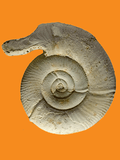 Abstract: Many outcrops exposing the Mid-Callovian/Upper Callovian boundary have been found near Montreuil-Bellay (Maine-et-Loire). The
lowermost bed of the Upper Callovian has been dated as the Leckenbyi horizon. It contains an abundant ammonite fauna (3125 specimens), in which Perisphinctidae make up
just over half of the specimens. In company with reasonably well-known species such as Pseudopeltoceras leckenbyi (Bean), Orionoides pseudorion (Waagen), Subgrossouvria famulum (Bean) and S. crassa Gérard
et Contaut, occurs a species, previously unknown,
which is described in this article. Choffatia isabellae n. sp. differs markedly from contemporary
Perisphinctidae,
for it is distinguished by : 1) a long, smooth juvenile stage, 2) weakly
developed ribbing, 3) the absence of parabolic ornamentation and 4) a high
frequency of constrictions. As this species is unknown in the fauna of the uppermost Middle
Callovian, along with many other species, including Peltoceras marysae Bonnot et alii, it must have colonised the northwestern part of the European platform via the southern margin of the
Tethys during the transgressive interval which started at the beginning of the Late
Callovian. This new species appears abruptly at the base of the Leckenbyi horizon, reaches its acme in the
middle of the horizon, where it probably represents half of the Perisphinctidae, before becoming rare in the upper part of the horizon, then
very rare in the Athleta horizon. Abstract: Many outcrops exposing the Mid-Callovian/Upper Callovian boundary have been found near Montreuil-Bellay (Maine-et-Loire). The
lowermost bed of the Upper Callovian has been dated as the Leckenbyi horizon. It contains an abundant ammonite fauna (3125 specimens), in which Perisphinctidae make up
just over half of the specimens. In company with reasonably well-known species such as Pseudopeltoceras leckenbyi (Bean), Orionoides pseudorion (Waagen), Subgrossouvria famulum (Bean) and S. crassa Gérard
et Contaut, occurs a species, previously unknown,
which is described in this article. Choffatia isabellae n. sp. differs markedly from contemporary
Perisphinctidae,
for it is distinguished by : 1) a long, smooth juvenile stage, 2) weakly
developed ribbing, 3) the absence of parabolic ornamentation and 4) a high
frequency of constrictions. As this species is unknown in the fauna of the uppermost Middle
Callovian, along with many other species, including Peltoceras marysae Bonnot et alii, it must have colonised the northwestern part of the European platform via the southern margin of the
Tethys during the transgressive interval which started at the beginning of the Late
Callovian. This new species appears abruptly at the base of the Leckenbyi horizon, reaches its acme in the
middle of the horizon, where it probably represents half of the Perisphinctidae, before becoming rare in the upper part of the horizon, then
very rare in the Athleta horizon.
|
|
Online since April 17, 2008
|
|
Memoir 1 [2008]: Description and illustration of forty-four
gilianelles (microproblematica) and ten other microproblematica of the
Cretaceous of the stratotype section at Tercis (Campanian-Maastrichtian
boundary), South-West France, by Gilles Serge ODIN.-
Format [HTML]
or [PDF
15.672 KB] / pages 45-75 with a coloured background [PDF
3,477 KB]
Reference: [CG2008_M01]
DOI:
10.4267/2042/16746
Lang.:
|
|
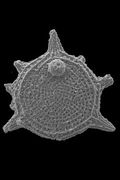 Abstract:
Following acetolysis, microproblematica were collected from indurated carbonates sampled from the stratotype section of the
Campanian-Maastrichtian boundary at Tercis (Landes, France). 44 taxa of the gilianelles group
(microproblematica probably pertaining to the Protista, Protozoans, Rhizopods) as well as ten other microproblematica were discriminated. To document the taxa in this paper 281 scanning electronic microscope images and 183 optical microscope images are presented. The gilianelles encompass 36 species, and 8 subspecies referred to 15 genera of which 14 are new. The new genera are: Tercensella, Azymella, Numismella, Aturella, Scutellella, Corniculum, Caccabella, Orculiella, Pennigerella, Corbella, Aquilegiella, Pocillella, Coraliella, Obbella. Among the other
microproblematica, nine species and one subspecies are proposed; they are referred to 7 new genera: Globulella, Piperella, Vasculum, Lucernellus, Cimicellus, Tubella, Pilella. This first general view uses normal taxonomic criteria to recognize and define a group of microfossils of which the identity and the consistency of occurrence are herewith established using the morphological characters of the body of the test, the presence and development of the expansions attached to that body, and its ornamentation. The use of these criteria in an ordered manner suggests that a rigorous taxonomic collocation is feasible, needing only a few other observations before becoming a formal classification. The statigraphic distribution of the taxa provides a means for establishment of a remarkable tool for relative dating in the stratotype section and its immediate vicinity ; microproblematica allow the sequence to be subdivided into intervals of deposition on the order of 0.1 Ma, a length of time shorter than the intervals obtained using the many microfossil or macrofossil groups previously employed to calibrate the stratotype. The Campanian-Maastrichtian boundary is within the limits of the genus Aturella lineage in the basal portion of the range of Aturella edentula. Abstract:
Following acetolysis, microproblematica were collected from indurated carbonates sampled from the stratotype section of the
Campanian-Maastrichtian boundary at Tercis (Landes, France). 44 taxa of the gilianelles group
(microproblematica probably pertaining to the Protista, Protozoans, Rhizopods) as well as ten other microproblematica were discriminated. To document the taxa in this paper 281 scanning electronic microscope images and 183 optical microscope images are presented. The gilianelles encompass 36 species, and 8 subspecies referred to 15 genera of which 14 are new. The new genera are: Tercensella, Azymella, Numismella, Aturella, Scutellella, Corniculum, Caccabella, Orculiella, Pennigerella, Corbella, Aquilegiella, Pocillella, Coraliella, Obbella. Among the other
microproblematica, nine species and one subspecies are proposed; they are referred to 7 new genera: Globulella, Piperella, Vasculum, Lucernellus, Cimicellus, Tubella, Pilella. This first general view uses normal taxonomic criteria to recognize and define a group of microfossils of which the identity and the consistency of occurrence are herewith established using the morphological characters of the body of the test, the presence and development of the expansions attached to that body, and its ornamentation. The use of these criteria in an ordered manner suggests that a rigorous taxonomic collocation is feasible, needing only a few other observations before becoming a formal classification. The statigraphic distribution of the taxa provides a means for establishment of a remarkable tool for relative dating in the stratotype section and its immediate vicinity ; microproblematica allow the sequence to be subdivided into intervals of deposition on the order of 0.1 Ma, a length of time shorter than the intervals obtained using the many microfossil or macrofossil groups previously employed to calibrate the stratotype. The Campanian-Maastrichtian boundary is within the limits of the genus Aturella lineage in the basal portion of the range of Aturella edentula.
|
|
Online since March 22, 2008
(Supplement online since March 27, 2008)
|
|
Article 4 [2008]: Diagenetic rejuvenation of raised coral reefs and precision of dating. The contribution of the Red Sea reefs to the question of reliability of the Uranium-series datings of middle to late Pleistocene key reef-terraces of the world, by Jean-Claude
PLAZIAT, Jean-Louis REYSS, Abdelmajid CHOUKRI & Charlotte CAZALA.-
Format [HTML] or [PDF
2,228 KB]
Reference: [CG2008_A04]
DOI:
10.4267/2042/16743
Lang.:
|
|
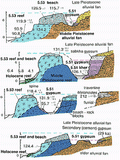 Abstract: This paper is a general review of the dating of reefs on the coasts of the Red
Sea, including those of Egypt, Jordan, Sudan, Eritrea, Saudi Arabia and Djibouti. New methods of sampling and dating
(U/Th) already tested on the reefs and associate deposits of the African coast of Egypt have demonstrated that processes of rejuvenation shown to exist in the best-preserved corals are attributable to the diagenesis of the organic material in their
bio-minerals, thus justifying a revision of a great many datings of corals supposedly younger or older than the age assigned to the high-level isotopic substage (δ18O) MIS 5.5 (= 5e). During this late Pleistocene
substage, a rapid lowering of sea level, short and limited to about ten meters, was detected and associated with a
glacio-eustatic episode of global influence. A comparison of these Middle East reef chronologies with those of New
Guinea, Australia and the western Atlantic that are referred only with difficulty to the δ18O global sea-level
curves, casts doubt on the reliability of many regional reconstructions. Moreover the most
"classic" reef chronologies, more or less out-of-phase with global isotopic records calls for a reexamination of the
chronologic basis of the reference curves derived from marine isotopic data. Abstract: This paper is a general review of the dating of reefs on the coasts of the Red
Sea, including those of Egypt, Jordan, Sudan, Eritrea, Saudi Arabia and Djibouti. New methods of sampling and dating
(U/Th) already tested on the reefs and associate deposits of the African coast of Egypt have demonstrated that processes of rejuvenation shown to exist in the best-preserved corals are attributable to the diagenesis of the organic material in their
bio-minerals, thus justifying a revision of a great many datings of corals supposedly younger or older than the age assigned to the high-level isotopic substage (δ18O) MIS 5.5 (= 5e). During this late Pleistocene
substage, a rapid lowering of sea level, short and limited to about ten meters, was detected and associated with a
glacio-eustatic episode of global influence. A comparison of these Middle East reef chronologies with those of New
Guinea, Australia and the western Atlantic that are referred only with difficulty to the δ18O global sea-level
curves, casts doubt on the reliability of many regional reconstructions. Moreover the most
"classic" reef chronologies, more or less out-of-phase with global isotopic records calls for a reexamination of the
chronologic basis of the reference curves derived from marine isotopic data.
|
|
Online since March 22, 2008
|
|
Article 3 [2008]: New biohorizons and proposal for a revision of the ammonite biozonation of the Upper Barremian of southeastern France, by Didier BERT, Gérard DELANOY & Stéphane BERSAC.-
Format [HTML] or [PDF
346 KB]
Reference: [CG2008_A03]
DOI:
10.4267/2042/16737
Lang.:
|
|
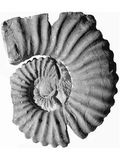 Abstract: New biohorizons and proposal for a revision of the ammonite biozonation of the Upper Barremian of southeastern France.-
A new ammonite biozonal scheme is proposed for the Upper Barremian of southeastern France. It takes into account faunal changes, sequence stratigraphy and historical data. Four new biohorizons are proposed. At present, three (formerly six) are accepted for the Upper
Barremian: the Vandenheckei, Sartousiana and Giraudi biozones. The first contains three subzones, the Uhligi (current status discussed), the Sayni and the Barremense subzones, and two new
biohorizons, the Marchandi and Breistrofferi biohorizons (top of the Barremense Subzone). The Sartousiana Biozone now includes the
Limentinus, Provincialis and Feraudianus subzones. This last one lost its status of biozone because of paleontologic and stratigraphic arguments. Six biohorizons are recognized in the Sartousiana Biozone: the
Limentinus, Provincialis, Casanovai, Feraudianus, Magnini and Autrani
biohorizons. The Giraudi Biozone includes the Giraudi, Sarasini and Waagenoides subzones and the
Giraudi, Emerici and Puzosianum biohorizons. Abstract: New biohorizons and proposal for a revision of the ammonite biozonation of the Upper Barremian of southeastern France.-
A new ammonite biozonal scheme is proposed for the Upper Barremian of southeastern France. It takes into account faunal changes, sequence stratigraphy and historical data. Four new biohorizons are proposed. At present, three (formerly six) are accepted for the Upper
Barremian: the Vandenheckei, Sartousiana and Giraudi biozones. The first contains three subzones, the Uhligi (current status discussed), the Sayni and the Barremense subzones, and two new
biohorizons, the Marchandi and Breistrofferi biohorizons (top of the Barremense Subzone). The Sartousiana Biozone now includes the
Limentinus, Provincialis and Feraudianus subzones. This last one lost its status of biozone because of paleontologic and stratigraphic arguments. Six biohorizons are recognized in the Sartousiana Biozone: the
Limentinus, Provincialis, Casanovai, Feraudianus, Magnini and Autrani
biohorizons. The Giraudi Biozone includes the Giraudi, Sarasini and Waagenoides subzones and the
Giraudi, Emerici and Puzosianum biohorizons.
|
|
Online since March 20, 2008
|
|
Letter 1 [2008]: Characterisation of the organic matter of upper Bedoulian and lower Gargasian strata in the historical stratotypes (Apt and Cassis-la-Bédoule areas, SE France), by François BAUDIN, Michel MOULLADE & Guy TRONCHETTI.-
Format [HTML] or [PDF
180 KB]
Reference: [CG2008_L01]
DOI:
10.4267/2042/14860
Lang.:
|
|
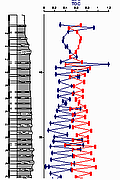 Abstract: The Total Organic Carbon (TOC) content of the Gargasian strata studied in their historical stratotype area is rather low (0.3% on average). Only a few levels show TOC values approaching 1.2%. This small amount of preserved organic matter, associated with low hydrogen index values (10 to 115 mg hydrocarbons/g TOC), argues for deposition in fully oxic conditions. This organic content is a mixture of land-derived organic particles and deeply
oxidized marine organic matter. The organic flux was strongly diluted by the autochthonous carbonate input. Abstract: The Total Organic Carbon (TOC) content of the Gargasian strata studied in their historical stratotype area is rather low (0.3% on average). Only a few levels show TOC values approaching 1.2%. This small amount of preserved organic matter, associated with low hydrogen index values (10 to 115 mg hydrocarbons/g TOC), argues for deposition in fully oxic conditions. This organic content is a mixture of land-derived organic particles and deeply
oxidized marine organic matter. The organic flux was strongly diluted by the autochthonous carbonate input.
|
|
Online since February 4, 2008
|
|
Article 2 [2008]: New micropalaeontological studies on the type section of the Campanian-Maastrichtian at Tercis (SW France): new ostracodes obtained using acetolysis, by Bernard ANDREU & Gilles Serge ODIN.-
Format [HTML] or [PDF
2,490 KB]
Reference: [CG2008_A02]
DOI:
10.4267/2042/14857
Lang.:
|
|
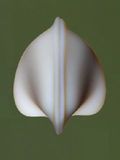 Abstract: Through the use of acetolysis new micropalaeontological studies on the type section of the Campanian-Maastrichtian boundary at Tercis (SW France) we obtained additional information on ostracodes. Acetolysis on hard carbonates levels of the Tercis quarry found 22 species in addition to those of the studies published in 2001. Today, 75 species are recognized: they represent 34 known genera, and 4 currently unidentified. Small species usually rare of the genera Aversovalva, Bythoceratina and Eucytherura were collected. All of the assemblages (of both genera and species) are characteristic of a
Campanian- Maastrichtian open carbonate platform environment. Abstract: Through the use of acetolysis new micropalaeontological studies on the type section of the Campanian-Maastrichtian boundary at Tercis (SW France) we obtained additional information on ostracodes. Acetolysis on hard carbonates levels of the Tercis quarry found 22 species in addition to those of the studies published in 2001. Today, 75 species are recognized: they represent 34 known genera, and 4 currently unidentified. Small species usually rare of the genera Aversovalva, Bythoceratina and Eucytherura were collected. All of the assemblages (of both genera and species) are characteristic of a
Campanian- Maastrichtian open carbonate platform environment.
|
|
Online since February 4, 2008
|
|
Article 1 [2008]: Planktonic and benthic foraminiferal assemblages and biostratigraphy of the uppermost Bedoulian and lower Gargasian of La Tuilière - St-Saturnin-lès-Apt (area of the Aptian stratotype, Vaucluse, SE France), by Michel
MOULLADE, Guy TRONCHETTI & Jean-Pierre BELLIER.-
Format [HTML] or [PDF
7,370 KB]
Reference: [CG2008_A01]
DOI:
10.4267/2042/14699
Lang.:
|
|
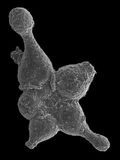 Abstract: Research on the Bedoulian and Gargasian of the Cassis-La Bédoule
(Bouches
du Rhône, SE France) area is extended, by a study of four overlapping sections in the stratotypic area of the Aptian stage in the hamlet of La Tuilière (commune of
Saint-Saturnin-lès-Apt, Vaucluse, SE France). This new information permitted a detailed analysis of upper Bedoulian and lower Gargasian benthic (30
taxa) and planktonic (15 taxa) foraminiferal assemblages. Here we describe, illustrate and give the ranges and distribution of the most significant forms, and call attention to several benthic and
planktonic species that may serve as extra-regional markers. Abstract: Research on the Bedoulian and Gargasian of the Cassis-La Bédoule
(Bouches
du Rhône, SE France) area is extended, by a study of four overlapping sections in the stratotypic area of the Aptian stage in the hamlet of La Tuilière (commune of
Saint-Saturnin-lès-Apt, Vaucluse, SE France). This new information permitted a detailed analysis of upper Bedoulian and lower Gargasian benthic (30
taxa) and planktonic (15 taxa) foraminiferal assemblages. Here we describe, illustrate and give the ranges and distribution of the most significant forms, and call attention to several benthic and
planktonic species that may serve as extra-regional markers.
The study of the planktonics in these expanded and continuous sections made it possible to strengthen the zonation which had been established in the Lower Aptian stratotype of Cassis-La
Bédoule, i.e. a succession of five zones (cabri, luterbacheri, ferreolensis, barri,
algerianus); this zonal scheme is improved by the addition of a horizon with Globigerinelloides ferreolensis heptacameratus
nov. subsp., which straddles the boundary between the luterbacheri and ferreolensis zones. We also show the temporal quasi-coincidence of: 1) the top of the Furcata ammonite
Zone, 2) the lithological change named "change of color" and 3) a triple micropaleontological datum (FAD of Praehedbergella luterbacheri, LAD of Protocythere bedoulensis and Lenticulina cf. nodosa) of which the importance in the stratotype of Cassis-La Bédoule had already been pointed out. All these data may be valuable in the definition of the
Bedoulian-Gargasian boundary.
Within the luterbacheri Zone of the early Gargasian, an episode probably of volcanic origin that we interpret as the equivalent of the Van Gogh Level (initially detected in the Vocontian domain), is marked by a strong crisis in the diversity of epibenthic and planktonic foraminifers, as well as in that of the ostracodes.
From a paleoecological and paleobiogeographical point of view, a comparison of the benthic and planktonic foraminiferal assemblages of La Tuilière with those of neighbouring areas reveals specific features related to paleodepth and shows affinities which appear to be closer with the microfaunas of certain boreal areas
(e.g. northern Germany) than with the Tethysian realm.
|
|
Online since January 28, 2008
|
|
|
|